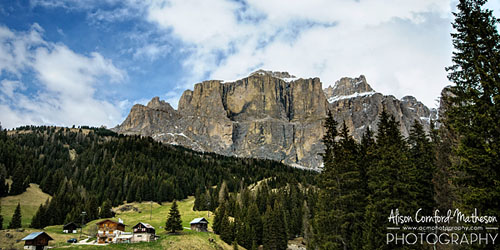
Hear about travel to the South Tyrol region of Italy as the Amateur Traveler talks to Alison and Andrew Cornford-Matheson from CheeseWeb.eu about their recent trip to this lovely region in Northern Italy.
This predominantly German-speaking region of Italy includes portions of the Dolomites mountain range, a wine road, and some great vistas.
“If you can picture the Northeast corner of Italy, way up in the mountains, that is a region called South Tyrol. It is often confused with Tyrol in Austria. I would say that the number one reason to go there is that it is absolutely beautiful. If you keep a checklist of UNESCO World Heritage sites, the Dolomite mountain range is in that part of Italy and it is absolutely gorgeous. Even better you can drive through them. There are a lot of twisty mountain roads that go up up up until you are in the sky.”
“If you are a wine lover or a foodie the wines in that region are just gorgeous and one of the reasons that we went. They have the South Tyrolean Wine Road. You get a mix of both [red and white wines] which is nice. They have a bit more on the white side but their reds are very rich delicious wines to drink on a warm day or even over the winter.”
“We visited in the Spring and it was perfect. We had great weather. Our main goal was to do some driving in the mountains, to taste the food and to visit some of the farm areas there so Spring was perfect for that. But, of course, if you are into winter sports, you can’t beat winter in the mountains. Frankly, some of those mountains still had plenty of snow on them. You could be skiing them in the spring.”
“We stayed at two different farms. One produced wine and apples which was a great combination because we got to drink wine in the evenings and fresh apple juice in the mornings with our breakfast. The second farm we stayed at was an actual family farm. They had cows for milking. That was their main business.”
subscribe: rss feed | Apple podcasts
![]()
right click here to download (mp3)
right click here to download (iTunes version with pictures)
Show Notes
CheeseWeb.eu
South Tyrol
Dolomites
South Tyrolean Wine Road
Roter Hahn / Red Rooster
Eppan
Bolzano
Tramin
Sella Pass
Cheese Museum (site not in English)
Museum of Archaeology
Tips for Hiking in the Dolomites
News
Why selfies with tigers may soon be illegal in New York
Is Southwest Airlines’ marketing strategy putting passengers in danger?
Community
Meetup in Boston – June 30th 2015
Transcript
Chris: Amateur Traveler, Episode 425. Today the Amateur Traveler talks
about wine, a museum dedicated to cheese and the Dolomites as we go to South Tyrol in Italy.
Welcome to the Amateur Traveler. I’m your host, Chris Christensen.
Before we get into our interview today, I did want to remind you that there are still spots available for the Amateur Traveler trip, April 2015, to Morocco. So check that out. Just go to the Amateur Traveler site, and under the book travel tab, there is a link there for that trip.
INTERVIEW
I’d like to welcome to the show Alison and Andrew Cornford-Matheson
from CheeseWeb.eu who have come to talk to us about Southern Tyrol which is in Northern Italy. Alison and Andrew, welcome to the show.
Alison: Hi, Chris. Thank you.
Andrew: Thanks, Chris.
Chris: We won’t talk about how many times it took for me to say your last names correctly.
Alison: Sorry about that.
Chris: Where are we talking about when we talk about Southern Tyrol?
Alison: Well, if you can picture the northeast corner of Italy, way up in
the mountains, that is a region called South Tyrol. It is often confused
with Tyrol in Austria, but this is a totally different place.
Andrew: But they do speak German in Italy.
Alison: They do speak German, which is confusing.
Andrew: It is Southern Tyrol in Northern Italy and they don’t speak Italian. They speak German. Now that all of your listeners are completely confused, it’s an area with a lot of history as you can tell with it being in Northern Italy and German-speaking. That whole area of Northern Italy and the borderlands there, there is a lot of history there in terms of different cultures and different wars that have happened there. It’s made for a really interesting mix.
Chris: Why should someone go there?
Alison: I would say the number one reason to go there is it is just absolutely beautiful. If like me, you are somebody who keeps a checklist of UNESCO World Heritage Sites…
Chris: Mm-hmm. I do.
Alison: The Dolomite mountain range is in that part of Italy and it is
absolutely gorgeous.
Andrew: Yes. Even better, you can drive through them. If you like driving, as I do, there are lots of twisty mountain roads that go up, up, up, up until you’re in the sky.
Alison: Also, if you are a wine lover or a foodie, the wines in that region are just gorgeous. One of the reasons that we went, also to do with driving, is they have what they call the South Tyrolean Wine Road, which is also a mouthful. Gorgeous wines.
Chris: You say gorgeous wines. When I think of Italy, I tend to think red
wines. You say German-speaking and I tend to think white wines. So what am I looking at in the Wine Road up there?
Alison: You actually get a mix of both, which is nice.
Chris: OK.
Andrew: You get more on the white side, but their reds are very rich and delicious wines to drink on a warm day or even over the winter.
Chris: You say over the winter and that actually begs the question of when is the best time to visit this region?
Alison: I think it really depends what you’re after. For us, we visited in the spring and it was perfect. We had great weather. Our main goal was to do some driving in the mountains, to taste the food and visit some of the farm areas there. So spring was perfect for that. However, if you’re into winter sports such as skiing and snowshoeing and that sort of thing, winter in the mountains, you can’t really beat it.
Andrew: Frankly some of those mountains still had plenty of snow on them. You could have been skiing them in the spring.
Alison: Yes, that’s true.
Chris: I do have to ask, you’re visiting farms here and your website is
CheeseWeb.eu, were you, in fact, looking for good cheese?
Alison: We’re always kind of looking for good food in general. Cheese is definitely a bonus. We did find some great cheese, although it wasn’t at the farms we were staying at. We stayed at two different farms. One produced wine and apples, which was a great combination because you get to drink great wine in the evening and fresh apple juice in the morning with our breakfast.
Chris: You stayed at the farm so it is agri-turismo?
Alison: Yeah. We actually booked both places through a company called Roter Hahn in German and Red Rooster in English. They specialize in farm stays and have over 1600 different farms. When I first heard farm stay, I thought this was going to be really rustic. Are we going to be sleeping in a cow shed? They were really luxurious places.
Andrew: They were really luxurious cow sheds.
Alison: They were very luxurious cow sheds. These cows had it really good.
Andrew: The Red Rooster organization is basically an association of individual farm owners. It’s not like they’ve gone and bought up a bunch of farms and they run it as their entity. The association just aggregates together as a cooperative almost to help bring more marketing power to these farms so that there is more awareness.
More importantly, for the consumer they bring a level of quality and control on what is being offered through the farms. They have their own rating systems for the services offered by each farm. Then they also do quality checks. Having met with some of these people, we were also impressed that they also provide additional facilities for the farms in terms of training them on the different business side of things. Helping them with paperwork that you have to do in Italy.
Alison: They even did language lessons. If you wanted to open your farm up to tourists, but you don’t speak English, you could take classes through Red Rooster.
Chris: You say the paperwork. That would be the paperwork to become an official agri-turismo which would give you some government… I don’t know if it’s aid or some help in terms of the ability to continue to run your farm, which is why a lot of people do this.
Alison: Yes. Exactly. I’m sure everybody is aware that Italy, like a lot of other countries in Europe, has to have paperwork for everything that you do. There’s a lot of documents you end up pushing around to run a farm and then to add on top of that, allowing people to stay on your farm.
Andrew: You’re also offering them breakfast, so there is a certain quality
there that has to be done for food. All of that has to be checked, double
checked and triple checked.
Chris: You say 1600 farms. That all can’t be in Southern Tyrol. I’m guessing not all in Italy, also. It’s a regional thing?
Alison: Actually it is. It’s all in South Tyrol. Believe it or not.
Chris: Sixteen hundred farms in Southern Tyrol?
Alison: Crazy, right? The whole area is just really rural and farms. Like I said, it’s not really what you’d expect when you think of a farm. The first place we stayed was a vineyard, but it was actually right in the middle of a village called, Eppan or Appiano in Italian, because everything has two names there. We were surrounded by grapevines on one hand, but you’re in the heart of this little village too. It was really different.
Andrew: The second farm we stayed at was a family farm. They had cows for milking. That was their main business. For the tourists, they had brought in some goats and chickens for eggs. With each stay you could arrange to have a visit with the farm and if you wanted to participate, in many cases you could. As part of the mandate or mission of the organization is to get more people exposed to farms and what farm life is like in a relatively more modern…
Alison: In a sanitized way.
Andrew: It was fabulous. 1600 farms. You have to imagine that it’s all three to six rooms total. There will be different levels of what’s in those combinations.
Chris: Interesting. What kind of itinerary would you recommend as we back up here a little bit and look at the big picture?
Alison: Again, I think it really depends what you’re after. We were there for some great driving, wine tasting and some site seeing.
Chris: Given that, what itinerary did you use?
Alison: We live in Belgium, so we drove. We had our own car.
Chris: This sounds like a region you’re going to want your own car, even if it is a rental.
Alison: Yeah. Bolzano is the capital of the area. You can fly in there and rent a car. It is possible to do train as well, but you’re not really going to be able to get out into the teeny places on the terrain. I would recommend flying in and renting a car. We based ourselves for the beginning of the tour in Eppan. This is really right in the heart of the South Tyrolean Wine Route. You can kind of town hop through really colorful pretty villages like Tramin where there is a huge wine cantina that makes beautiful wines.
One of the other fun things we did in Caldaro was there is a funicular that takes you way up into the mountains. You get just an absolutely gorgeous view of the area. So that took about 30 minutes to get to the top. 20 minutes?
Andrew: Yeah, 20 minutes. Something like that.
Alison: Then you can kind of take an hour or so and walk around up there. There are shops and there’s a cafe with the most incredible view. Then pop back down on the funicular and continue along the Wine Road.
Andrew: Down the Wine Road. Yeah.
Chris: In terms of the Wine Route, this is something that people can find online? Where the Wine Road goes? Or are there pamphlets from the tourism board or both?
Alison: Yes. There are both. They actually provide a Wine Pass. So if you don’t want to taste wine and then get back in your car, which is not always a great idea, the Wine Pass will give you access to their public transportation. That actually includes the funiculars as well. So that’s how we ended up on the Mendola Funicular. So you can use the Wine Bus and hop on that way.
Andrew: I think that’s great. There’s a wine bus.
Chris: Sure.
Alison: Everybody needs a Wine Bus.
Chris: I’d have a wine bus or a wine train. I notice that when I looked up Tramin on the web, it’s actually Tramin an der Weinstraße or on the Wine Route. It is the home of Gewürztraminer. That’s why I looked it up to see if that was going to be the case. That’s actually one of the first wines that I liked. So spicy white wine.
Alison: Yeah. Absolutely. They do send some great ones there. Like we said, there is a whole range from citrus-y sauvignons right up to the punch you in the face, spicy reds. Really something for everyone.
For the itinerary, I guess the second half of our trip when we went to the dairy farm, that was on the other side of the mountains. One of the highlights there was driving over the Sella Pass. Andrew loves driving on switchback-y mountain roads.
Andrew: The smaller the better. The more scared Alison is, the better the road is, really.
Alison: Yeah. I had some white knuckle moments.
Andrew: The drive up through the mountains is spectacular because they have the forests and then you have the Dolomites. It’s really rocky. When you get to the top, there is still snow up there. You have little sections of road that have gone away over the winter and have been rebuilt.
Alison: Yeah. You want to make sure you have really good tires on your car.
Andrew: It takes you a day to do that sort of drive. If you’re doing that sort of distance, you want to make sure you have a day. I really recommend that you investigate whether the passes are open or not. We didn’t think of it ahead of time. We were going in one direction and we got to a point where the sign said the pass is closed. It was like, “Oh crap.”
Alison: Yeah. Oddly enough, they do have snow in the mountains in May.
Chris: Right.
Andrew: So we were fortunate we found another pass. We went and met up with our hosts that night. They were actually amazed that that pass was open, because earlier in the week, it had been closed. Just keep an eye on, not just the weather but also whether the passes are open if you’re going to go drive through the mountains.
Alison: Even the second farm that we stayed in, they had lost their main
road over the winter. We got e-mailed these really cute directions that said something like, “Drive left until you see a sign saying that you’re not allowed to drive anymore, but then ignore the sign and keep driving.” Okay.
Andrew: When we got up into the dairy farms because it’s all in the mountains, they don’t plan on getting anywhere quickly. For us to go to dinner, we went to a fabulous place when we were there called Mizarstvo [SP] and it’s just on the other hill, but to get to that other hill, you have to go all way down the current hill, across the valley and all the way up the other hill. What should be only a few minutes is a half hour drive.
Alison: Everything takes longer.
Andrew: But that’s nice. It’s a nice slow way of seeing things. I think earlier, Chris, you had asked us whether we had cheese while we were there. When we were over at this dairy farm, they did milk and they did their own yogurts and cheeses…
Alison: Butter.
Andrew: …and butter. That was all wonderful, but Alison is a big fan of goats. On our drive through the valley there, we happened to pass a museum dedicated to goats and goat milk and goat cheese.
Alison: It was kind of my heaven. Not only did it have a museum and a cheese shop, but it had a wine shop and a bistro.
Andrew: I almost lost her there.
Chris: I’m guessing we’re not talking about a large museum at this point.
Andrew: No.
Alison: The whole facility was actually quite big and modern. It’s called Capris and it’s a going concern in the area. It’s like a cooperative, I guess. They’ll take dairy from local goat farmers and produce all these products.
Andrew: The museum was well done. It wasn’t huge, but it was a little more interactive than most museums. There’s one section of it, you go through and you’re walking through a room that is milk dripping down from the ceiling. There are just these balls of…
Alison: You’re supposed to be a molecule of milk or something. Anyway, they had goats. They had cheese. I was happy.
Andrew: It was funny to run across that was kind of fun.
Chris: Now I get the sense from the region that you’re talking about, we’re talking predominantly rural. We’re not going to be talking, in
terms of cultural things, a lot of museums and orchestras and operas and those sorts of things, but more landscapes and farms.
Alison: Operas, probably not, although there may be one in Bolzano. Bolzano, we didn’t spend any time there, but it’s actually quite a fair-sized city and there are a lot of museums and cultural centers there. There are some small museums dotted around particularly for archeology and those types of things. The big thing in the area is castles. They are just absolutely littered with castles. If you’re into historical castle and ruin visits, it is definitely the place to go.
Andrew: If you’re interested in the ice age, then the archeological museum in Bolzano has… You may have remembered about 20 or 30 years ago, they found the iceman buried in the ice of one of the glaciers in the mountains. So he’s actually in the Museum of Archeology in Bolzano.
Chris: OK.
Andrew: You could go visit his remains there, which some people might be interested in that. I was certainly interested in it. We just didn’t get a chance to get there.
Chris: You mentioned a lot of castles. Did you stop at any or have any that you would recommend?
Alison: We didn’t go into any, but we certainly saw a ton. Even just
driving.
Chris: Andrew likes to drive and you couldn’t get him to stop is really what you’re saying.
Alison: Yeah. I know. It’s hard.
Andrew: Definitely.
Alison: That and when he’s stopping for the wine, he passes by the castles.
Andrew: What’s more important, right?
Alison: Yeah. Priorities.
Andrew: We were there for basically a four-day long weekend. we spent two days in the area in Eppan and then two days in the more rural area. Having done this, we would recommend four days minimum for the area, but you could easily spend a week.
Alison: I think you easily need a week. Especially if you want to spend some time in Bolzano and find the culture there and that kind of thing, I think easily a week.
Andrew: One of our friends has recommended that one of the castles near Bolzano has actually a really good restaurant in it. You take a cable car, I think, it was up to the…
Alison: Yeah. Right up from the center of Bolzano and you go up to this castle and the restaurant there is beautiful. You’re overlooking the whole valley and whole region.
Andrew: Do you remember the name of the castle?
Alison: I don’t.
Andrew: Schloss-something.
Chris: Schloss-something. The one at the end of the cable car.
Alison: Yeah.
Chris: That actually should be fairly easy to spot. Question for you. We’re talking about an area that is known for its physical beauty. You’re
standing in the prettiest spot that you visited. Where are you standing and what are you looking at?
Alison: For me, it was actually the balcony of the [inaudible 00:18:09], which was the second farm that we stayed at. It was just the most mind-blowing beautiful view with the top of this hill and the mountains stretched out before you. We stood there at sunset and it was just gorgeous. What would you say?
Andrew: That was beautiful, the colors on the Dolomites, especially with the snow. It was beautiful. I was thinking one of my favorites was when you were clinging to the side of the car while we were going up some of the mountain passes. In terms of just spectacular views, yeah, that was definitely the place to be.
Chris: What do the guidebooks recommend that you would say don’t spend your time doing that?
Alison: I think you’re going to be hard pressed to find a whole lot of information about this region.
Andrew: In English.
Alison: In English. Yeah. If you’re German, there are probably tons. A lot of German tourists visit there, but that’s about it. Not even a lot of Italians really visit this area too much. As an English speaker, you really will feel like the first English speaker who has ever been there in a lot of places.
One of the things that was really fun for us was that the primary language of most people was kind of a regional dialect of German, and then standard German, and then Italian and then maybe a little bit of English. When we would go to a restaurant or even the second farm, it was the kids that we ended up talking to because they were studying English in school. Whereas the parents hadn’t really taken a lot of English.
Andrew: Or it was years ago.
Chris: It was years ago, yeah.
Alison: So it was quite fun when we’d go into a restaurant and we’d start to talk and they’d kind of tell just to wait. They run over back and they grab one of their kids and bring the kid out to translate the menus for us.
Andrew: It feels like an undiscovered part of Europe. Yes, there’s a lot of Germans there and it is a very popular spot for German-speaking tourists, but for English speakers, it feels undiscovered.
Chris: Interesting. My normal question is, was there one of the locals
there that you met that you really wish everybody could meet? Was it one of the kids that you met somebody that you wish everybody could meet and maybe they could…?
Alison: They were all great. They were really great sports.
Andrew: Sandra from our second stay, she was super cute. She’s a big Justin Bieber fan. When we said we were from Canada, her eyes lit up. She said, “Justin Bieber!” We had a rapport there. It was funny because at a dairy farm, she didn’t spend a lot of time working at the farm. That was her father’s job. She was trying to translate the farm words to English words that she just couldn’t come to grips with what the translation would be. It was really cute. We got to see more of the family dynamic.
At many of these farms, because you’re interacting with the owners and the families that run them, I think they all have their special elements to them. I think that’s a great way of exploring the region and getting to know the area better.
Alison: Really, despite the language, everybody was super friendly.
Everywhere we went, people really tried to make us feel as welcome as possible and, yeah, share a little bit of what’s special about their region.
Chris: You mentioned the farm stays, we’ve talked about a couple of times, but is this something that is relatively affordable or is it a little more expensive? How does it rate versus staying at a small motel or something?
Alison: There’s really a range because the rating system ranges within the farms. Even the two places that we stayed, which were more on the top end of what you can expect there, were under 100 euros a night.
Andrew: And it’s multiple bedrooms.
Alison: Yeah. These were whole apartments. Not just a room. So you had a kitchen and multiple bedrooms.
Andrew: It runs the gamut in terms of what you want. If you’ve got a family, you have a couple of kids, then this is a very affordable way. We met a couple of other travelers who were there with families, and for them, this was the best way to stay with four people or more.
Alison: Yeah, you can really run the gamut right from budget to luxury.
Chris: The other question I had is, when you were talking about the Weinstraße and the wine route, and stopping at vineyards. Until recently, at least, a lot of the vineyards in Italy weren’t really set up to have tourists like we’re used to here up in California for instance, where it seems like everyone has a tasting room and is ready to receive visitors. That hasn’t been the case, at least until recently in Italy. What were you finding as you were stopping at vineyards?
Alison: Certainly this area is set up for wine tourism with the Wine Bus
and the Wine Road.
Chris: So you don’t need a reservation, for instance, or an appointment to stop at a particular vineyard. You could just pull off the road and…
Andrew: They’ll provide you some information at some of the stops. They’ll tell you when there is a reservation needed or when to stop in. Some of them will run tours. Let’s say, “At 11:00, we will run an English-speaking tour or a German speaking tour” or whatever. That’s information on the website. Also when you buy the card, you get that sort of information about what’s happening that day. That’s helpful.
Alison: Yeah. The bigger cooperatives, kind of each town has its own wine cooperative as well for the people who don’t actually make their own wine. Those seem to be pretty much open all the time and really set up for tastings.
Andrew: In each town along the way, it’s worth popping into the center there and seeing the architecture because they are all really cute little towns along the way, Tramin being one of them.
Alison: Very colorful and nice shady squares and that kind of thing.
Andrew: Also, remember that being Italy… Maybe it’s Germanic, but being Italy, from about noon until two or three in the afternoon, everything is pretty much shut.
Chris: OK.
Andrew: At that point in time you go and find a terrace and some dinner. Have your meal of the day. Just relax until everybody re-opens
again.
Chris: What surprised you about the region?
Andrew: Everything.
Alison: Yeah. We really went with no expectations. We were just blown away. I think Andrew was getting tired of me saying, every five minutes, “I can’t believe how beautiful it is here.” We’ve really traveled all over Europe, but this place just had everything.
Andrew: Yeah. Like I said before, it felt undiscovered. It’s German in
Italy. It’s got this beautiful wine valley, but it’s in the mountains.
Alison: Incredible food.
Andrew: It just was all of those extreme descriptions you can give it. It’s got low points and high points in terms of its altitude. Not good or bad, just altitude. For me, it was everything. I had no expectations. It seemed to just continue to surprise me.
Chris: OK. It feels like we’re winding down a bit here. Is there anything else we should know before we go to South Tyrol?
Alison: Be prepared to explore a bit on your own because it is quite undiscovered for the English language market. You have to be a little bit
brave about getting past the people not speaking English.
Andrew: Try the knödels.
Alison: Yes. Eat the dumplings.
Chris: So the food then is also a mixture.
Alison: Yeah. There is definitely Italian influences. You do see pasta, but it is a lot of hearty mountain food. There are dumplings everywhere, meaty, goulash-type stews.
Andrew: It’s got all the different foods you can probably want. I do recommend trying the knödel, which is German for dumpling.
Alison: Dumplings. They have dumplings of every flavor imaginable.
Andrew: Alison’s bought a whole book of how to make knödels.
Chris: You’re going to pack your corkscrew or your wine opener. What else are you going to pack for this area?
Alison: Layers for clothing because you are in the mountains. From the valley to the top of the mountain, the weather can change dramatically.
Andrew: Your camera.
Alison: You definitely want to pack your camera.
Andrew: A picnic basket would be a nice thing.
Alison: Mm-hmm. Yes. Definitely.
Andrew: We travel with a cooler so we can take stuff with us as we go. Just a sense of experimentation and adventure. There are all sorts of things to go and do.
Chris: Last three questions. One thing that makes you laugh and to say, “Only in South Tyrol.”
Alison: Somebody pulling their kid who was washing dishes out of the back of the restaurant to explain to you what’s in the dumplings.
Chris: Andrew, did you have a different answer?
Andrew: Mine was Sandra’s reaction to us being Canadian. Justin Bieber.
Chris: Finish this sentence. You really know you’re in South Tyrol when…
Alison: When you open the curtains in the morning and you’re staring at the Dolomites.
Chris: Excellent. We’ll have some links to some pictures or at least pictures in this episode for those who are watching the iTunes-enhanced version. If you had to summarize South Tyrol in just three words, what three words would you use?
Alison: Breathtaking, filling, because those dumplings are very heavy and undiscovered.
Chris: Where can people read more about your travels?
Alison: They can find us at CheeseWeb.eu and we have a couple of articles on there about our adventure in South Tyrol as well as other places that we have explored in Europe.
Chris: While we gave you a hard time about cheese, your site is not about
cheese?
Alison: No. You will find the occasional mention about cheese, but it’s really about living in Belgium because that is where we’re based. Also about exploring Europe and finding those undiscovered corners like South Tyrol.
Chris: Excellent. Our guests again, have been Alison and Andrew Cornford-Matheson from CheeseWeb.eu. Thanks so much for coming on Amateur Traveler and introducing us to South Tyrol.
Alison: Thanks for having us, Chris.
Andrew: Thanks, Chris.
NEWS
Chris: Two different news items caught my eye this week.
One of them is proposed legislation in New York that will soon make it illegal to take selfies with tigers. You may be asking, “Chris, why do we need a law like that?” Apparently, on dating sites, men have been taking pictures of themselves snuggling with tigers to get across the idea that they are brave or cuddly or implausibly both. In an assembly, a man who is trying to get that law passed says, “They can still pose with bears and monkeys. They just have to take big cats off their list.” I’m not sure this is a good idea. I think this may be nature trying to weed out the herd.
One columnist from the Washington Business Journal thinks that perhaps Southwest Airlines is also putting the herd in a bit of danger. For business consumers who don’t mind paying a premium, they are allowing early boarding which gets your choice of seats including the exit row and also free drink coupons for select business passengers. The problem is that this particular columnist has seen on two different occasions when the person who got on early and had already been drinking and may have already been legally drunk took the exit row and then continued to be served as many as five beers on a flight. Now the person between you and the emergency exit is drunk. This may also be a bad idea.
For links to both of those stories, check out the show notes at AmateurTraveler.com.
COMMUNITY
In news of the community, if you listen to this when it comes out, I’m doing a meet-up with fellow travel bloggers in Boston. If any of our listeners are also in the Boston area on June 30th, 2015, I would love to meet with you as well. Send me an e-mail to host at amateurtraveler.com and I’ll send you the details for that particular meet-up. I would love to see you. Don’t forget to sign up for the Morocco trip before all of those slots go away.
With that, we will end this episode of the Amateur Traveler. If you have any questions feel free to send an e- mail to host at amateurtraveler.com or leave a comment on this episode at AmateurTraveler.com. You can also follow me on Twitter @Chris2x and as always, thanks so much for listening.
Transcription sponsored by JayWay Travel, specialists in Central & Eastern Europe custom tours.
- Search for Great Tours HERE
- Get a Car Rental
- Book Your Accommodation HERE
- Get an eSim to be able to use your smartphone abroad.
- Buy Travel Insurance
- Get a universal plug adapter
+Chris Christensen | @chris2x | facebook
Leave a Reply
Tags: audio travel podcast, italy, podcast, south tyrol, wine

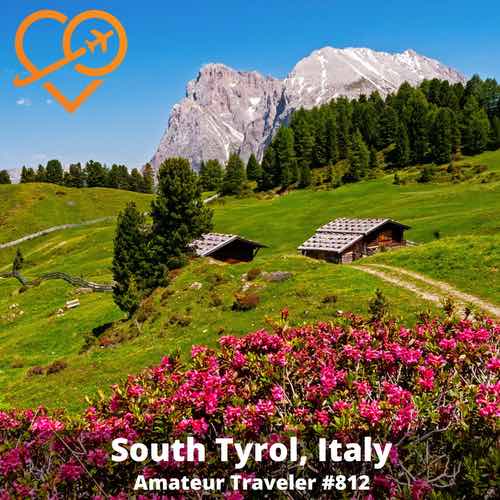 Travel to the South Tyrol, Italy – Episode 812
Travel to the South Tyrol, Italy – Episode 812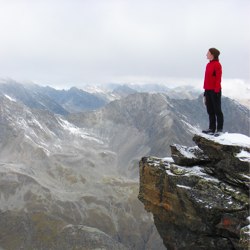 Travel to the Tyrol (Tirol) Region of Austria – Episode 207
Travel to the Tyrol (Tirol) Region of Austria – Episode 207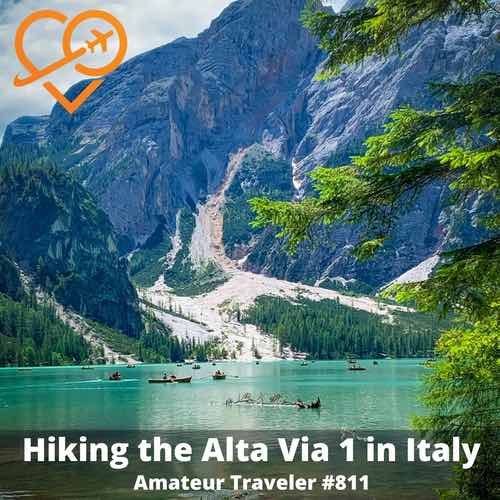 Hiking the Alta Via 1 in the Dolomites in Italy – Episode 811
Hiking the Alta Via 1 in the Dolomites in Italy – Episode 811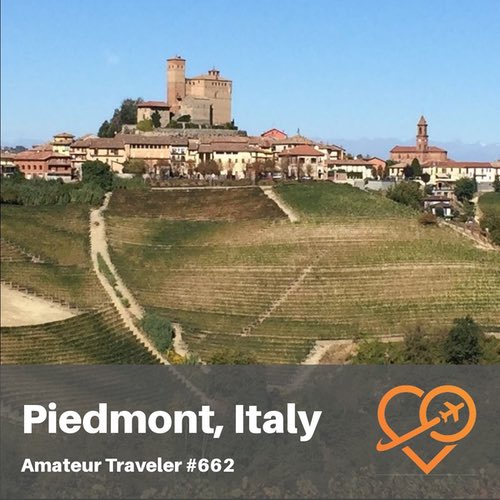 Travel to the Piedmont Region of Italy – Episode 662
Travel to the Piedmont Region of Italy – Episode 662
